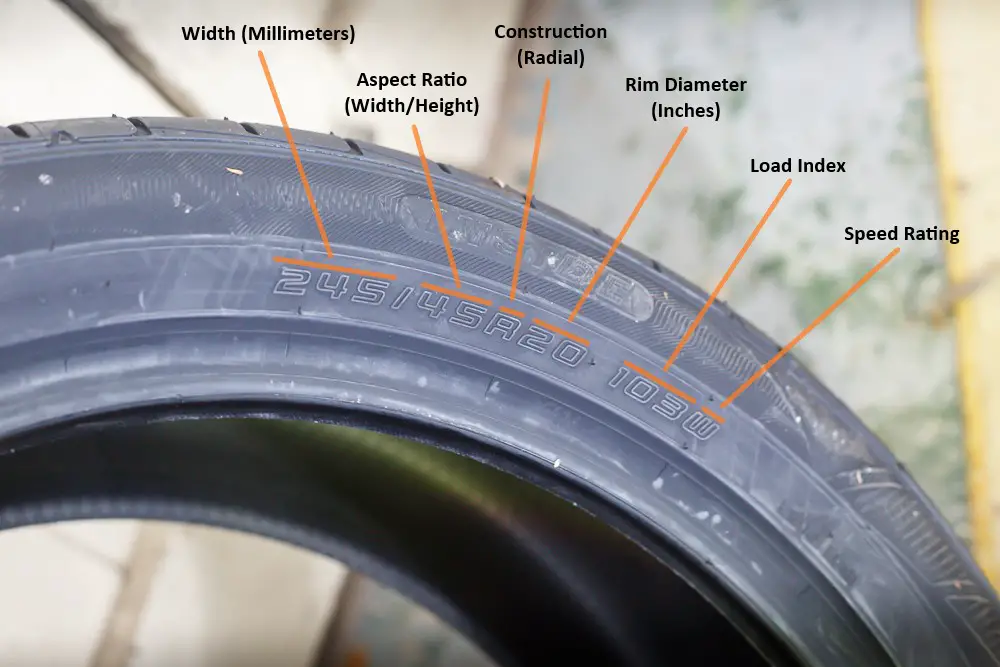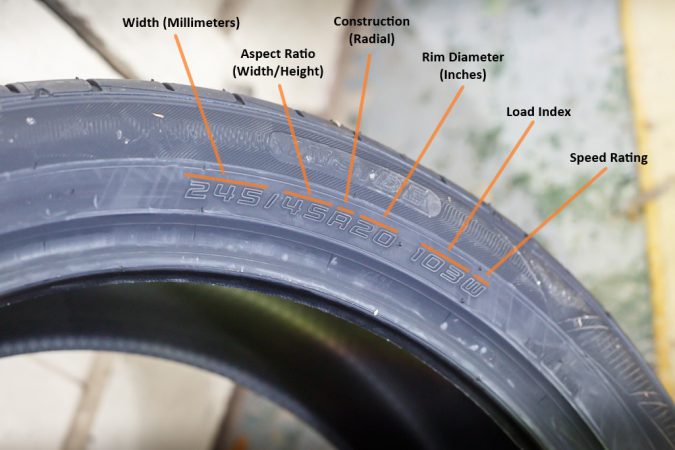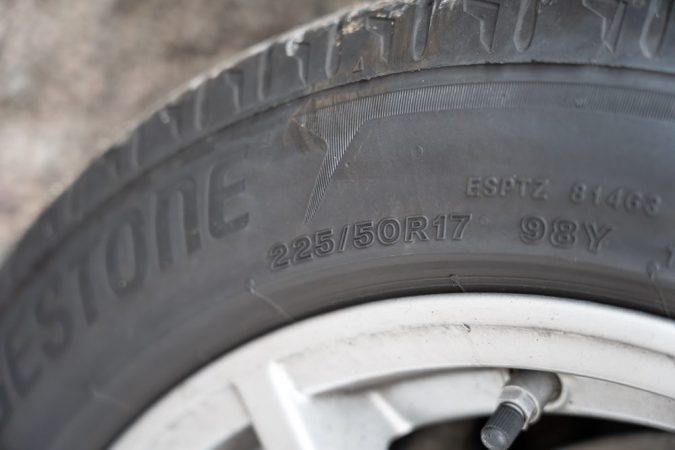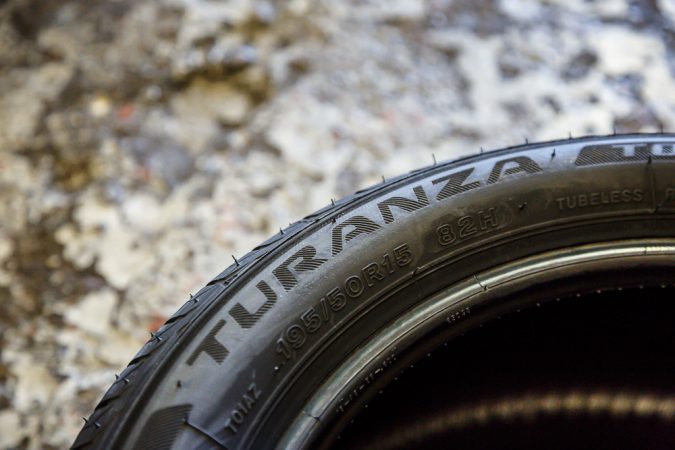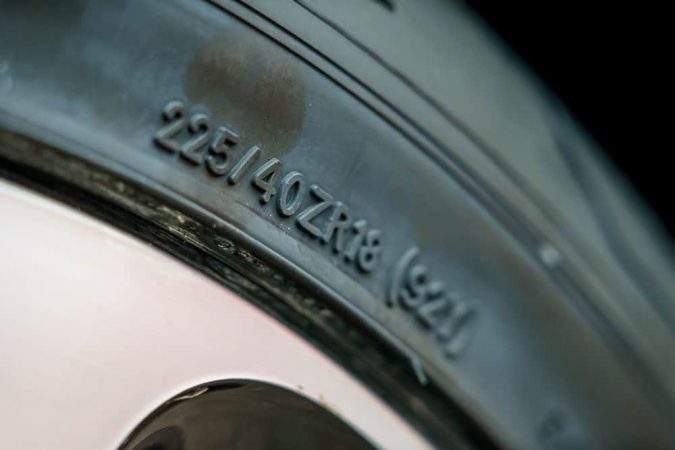Are you happening to be shopping around for a new set of tires? It’s slowly turning cold out, so you’ll probably need to get some winter tires out soon, huh? Or, perhaps you just kneeled down and got a bit curious as you peeked at your car’s running shoes… What do all those numbers and letters mean on my tires, anyway? To help you along, what you need, ladies and gentlemen, is a tire size chart.
After all, getting the right tires for your car is crucial. It’s just like getting an actual pair of shoes for your fleshy feet. One size too small, and it’ll pinch your bones together. One size too big, and you’ll be lucky it won’t fall out, unless you’re playing Cinderella. Only this time, take that analogy, but instead of walking speed, imagine it going at 100mph or more. That’s what your tires have to go through.
It’s not just the speed, either. Your tires have to hold out against immense pressure, load, and above all, last long enough that you won’t complain about needing a tire change every other mile. Thus, you have to pick tires of the right dimensions for your wheels. It needs to pair up snugly, as far as you’re going to be concerned about its width, diameter, type, build, and so forth. But how can you tell?
How do you know what tires are right, and which ones aren’t? To help you out, we have a detailed and comprehensive tire size chart to get you acquainted. So, feel free to bookmark this anytime you head out to a tire shop…
- What Does It All Mean?
- Reading The Lettering
- The Detailed Chart
- Sizing Conversion
- Some Examples
- Conclusion
What Do All Those Numbers And Letters On Your Tires Tell You, Anyway?
Reading what all that lettering on the side of your tires can feel like breaking the Enigma code when you’re seeing it for the first time. Admittedly, it can be quite inconsistent. Some figures are measuring in millimeters, while other measurements are in inches, for instance. Here’s one example of the same tire you saw in the thumbnail up above, and what it says on the sidewall…
The ‘tire size’ here reads: 245/45 R20 103W
It’s in these situations that having a tire size chart could be rather handy. That said, there are easier ways to decipher what each of those letterings denotes. To try and get a grip on this, it might prove useful to break them up into its constituent components. That’s because this entire string of letters or numbers tells you the entire specifications of your tire. This includes dimensions, tire type, and so on.
What They All Mean:
Here’s how we break down what that aforementioned tire size (245/45 R20 103W) on the sidewall means…
- A – There should be a “P”, “LT” or “ST” right at the front of the tire size marker. Unfortunately, our tire here doesn’t show it, but it appears often as the first letter.
- B (245) – It’s the tire width, measured in millimeters. Our tire right up there, therefore, should be 245 millimeters (mm) wide.
- C (45) – This is the aspect ratio, and no, it’s not the same as the aspect ratio of your screen. This tells us the tire profile, or how tall the tire’s sidewall is. There’s a formula for this, and ours ended up as 45. To put it another way, the sidewall is 45% of the tire’s width.
- D (R) – It should mean the type of tire you have, which in this example, is a Radial-type tire. In other words, this tells you what your tire is made of.
- E (20) – Following your tire construction, we get into the diameter of the wheel that the tires have to cover. Unlike the width, it’s measured in inches, so we have here a 20-inch diameter tire.
- F (103) – Now, we get into the load index. There’s a specific chart for this, and it tells you how much weight your tires can take. 103, with this tire, is a bit higher up than most tires.
- G (W) – Finally, we have the speed rating of the tire. Every alphabet corresponds to how much speed (measured in mph) can your tires take.
How Does All That Numbering And Lettering On Your Tires Come Together?
That was a highly condensed explainer, and each section of your tire size specifications (from A to F) has its own meaning behind it. That includes how certain numbers or letters appear as they are. Ultimately, it comes back to you and affects how you shop around for a new set of rubber. So, here’s a more in-depth look at what each section of these measurements unveils. Understanding them will be vital in reading a tire size chart.
A – Tire Type
As we mentioned earlier, this first letter that you’ll come across tells you what type of tire you have. Again, this particular set of tires didn’t have them, and there’s a good reason for it. We here in the good old United Kingdom follow a European measurement for reading tire sizes. This is typically called the “European sizing” or a metric tire. Just like shoes, they (well, we) have our own measurements.
If you’re on a holiday anywhere in Europe (or other regions that follow European tire size standards), this should be noted in case you’re planning to swap out the tires on your rental car. Otherwise, the rest of the readings are the same on either side of the pond. So, here’s what each of them reveals:
- P stands for “passenger vehicles”, and are the most commonly seen. P-class tires are fitted on a large variety of vehicles. These include cars, vans, SUVs, (small to medium) pickup trucks, crossovers, etc.
- LT stands for “light truck”, and it’s a step above the P-class tires. LT-class rubber is built for carrying heavy loads, hauling large trailers, and can stand heavy-duty work. Larger SUVs, pickup trucks, as well as actual commercial trucks, wear these tires.
- ST stands for “special trailer”, and it’s indeed a special one. Primarily, ST-class tires are worn on actual trailers, not powered vehicles. These include, for example, caravans, boat trailers, utility trailers, fifth wheels on RVs, and so forth.
B – Tire Width (Measured In Millimetres)
Following the first letter (P, LT, or ST), we should come across a three-digit number. This is a reading on how wide your tires are, measured in millimeters (1 inch is 25.4mm). It’s also otherwise referred to as the “tire section width”. To be more specific, the tire width should be how wide the tires are from one side to the other side, with you looking head-on.
C – Tire Aspect Ratio (Measured As A Percentage)
After the three-digit tire width, there should be a forward slash, and then you’re greeted with a two-digit number. The forward slash, mind you, helps to separate the tire width from the aspect ratio. So, what does an ‘aspect ratio’ mean when it comes to tire sizing? In a nutshell, this is your tire profile, or how tall your tires are. The larger the aspect ratio, the taller your tire’s sidewalls are.
To put it simply, look at your tire from the side. Now, see how much actual rubber there is between the edge of the rims or alloys, and the edge of the tire treads. Rather than simple measurement, the aspect ratio is calculated as an overall percentage of the tire width. Here’s a basic formula for how you can get the actual height of the sidewall in inches:
[Aspect Ratio – In Percentage] x [Tire Width – Converted Into Inches] = [Sidewall Height – In Inches]
Based on our tire size up above, this is what it turns out to be when we substitute all the numbers in:
[Aspect Ratio] = 45% (or 0.45 into your calculator)
[Tire Width] = 245mm (or 9.65 inches, after a quick Google search conversion)
(0.45) x 9.65 = 4.3425 inches (this is how tall your sidewalls are, or around 110.3mm)
D – Tire Construction
Sometimes, you’d find a space between the two-digit aspect ratio, followed by a single letter. Usually, this should be an ‘R’. This singular letter will let you know the internal structure of the tire. This is very important, as different construction and design of tires are used in varying applications. You’ll most likely come across three letters in most vehicle tire sizes:
- R is for Radial tires. This is by far the standard construction used for more tires on the road today, as far as four-wheeled vehicles go. Within a radial tire, there are individual plies laid perpendicularly in the tire. These plies are sturdy cords wound together through a blend of polyester, steel, fabric, and then coated in rubber
Radial-type tires mark a huge step forward in tire technology for what came before it. For most of us, it meant improved traction, lower rolling resistance (hence, better fuel efficiency), comfort, handling, and is more durable.
- D is for Diagonal tires. Alternatively, it’s meant to describe tires with crisscrossed plies, sometimes known as bias-constructed tires. Instead of using the plies from before, these “cross-ply” are rubber strands that are crisscrossed to provide structure to the tire. You’ll most often find D-type tires on motorcycles or trailers.
- F is for run-Flat tires. However, only some run-flat tires have this lettering embedded onto the tires, as others carried a simple Radial “R”. Run-flat tires are designed so that they could be punctured, but still maintain integrity to keep you driving on. Albeit, for a limited range and with a limited top speed.
E – Wheel Diameter (Measured In Inches)
Next, we have another two-digit number. This is to let you know how large your wheels are that the tires have to fit over. This time, we’re measuring it in inches. Look at your wheels (rims, or alloys) from the side, and measure the diameter from the two bead seat zones on opposing ends of the wheel. These ‘bead seat‘ areas are where the tire has to fit over and get snugly sealed with the wheels.
F – Tire Load Index
Moving on, we then find a two to three-digit number, informing us of a particular tire’s load index. In layman’s terms, the load index is how much weight (or mass, to be technical) a tire can feasibly support. This matters, as you’ll have to pick a load index that is sufficient for your application. If you have a 4-door hatchback, for instance. You won’t have to spring up for high load index tires.
But what if you have a humungous pickup truck, and you’re spending the day hauling lumber along? In that case, you need a tire with a very high load index to take on the extra weight. This two to three-digit number corresponds to an actual figure measured in pounds (lbs). Our particular tire here, for example, has a load index of 103.
Using the tire size chart that we’ve prepared down below, this means that the tire (load index 103) can take on a mass of 1,929lbs. Do bear in mind that this load index figure is for each tire. So, if you want to find out the total load index for your entire vehicle, simply multiply that by how many tires you have. For a four-wheeler passenger car:
1,929lbs x 4 tires = 7,716lbs (this is the maximum load/carrying capacity for your tires)
G – Tire Speed Rating
Finally, this will be the last letter in your tire size reading, which symbolizes your speed rating. This is an indication of the safest top speed for your tires to be subjected to for a sustained amount of time. Or, to put it simply, a higher speed rating signals that you can travel faster and for longer, without fear that your tires will explode. It ultimately varies based on a few factors.
Namely, these may factor in the amount of heat and pressure your tires are subjected to while driving at speed. Once again, the lettering for the speed rating corresponds to a figure in miles per hour, mph. For our sample tire, the speed rating is W. Using the tire size chart down below, this will be 168mph. If we were to travel above those speeds with these tires, a chance of a blowout rises greatly.
So, How Does A Tire Size Chart Look Like?
Having understood what each section of a tire size reading tells us, is there a chart for those figures that we can’t measure? Well, indeed there is, and that’s called a tire size chart. This exists simply due to the fact that some measurements would otherwise make a tire size specification a bit too complex. Instead of letting you know straight, tire manufacturers would prefer using a tire size chart.
For the most part, we can easily measure the rest. With a measuring tape, you instantly are aware of the tire width, wheel diameter, and sidewall height. A few taps on a calculator can then show you the aspect ratio. You don’t even have to worry about the construction type that much. But what about the load index and speed rating? To help you out, here’s a full tire size chart for those two in particular.
You can then very easily cross-reference this chart with the tires that you’re planning to get. Combined with the dimensions such as its width, diameter, and sidewall height, you’re now better armed with knowledge on tire sizing.
1. Tire Size Chart – Load Index
| Index | Load (lbs) | Index | Load (lbs) | Index | Load (lbs) |
| 65 | 639 | 94 | 1,477 | 123 | 3,417 |
| 66 | 661 | 95 | 1,521 | 124 | 3,527 |
| 67 | 677 | 96 | 1,565 | 125 | 3,638 |
| 68 | 694 | 97 | 1,609 | 126 | 3,748 |
| 69 | 716 | 98 | 1,653 | 127 | 3,858 |
| 70 | 739 | 99 | 1,709 | 128 | 3,968 |
| 71 | 761 | 100 | 1,764 | 129 | 4,079 |
| 72 | 783 | 101 | 1,819 | 130 | 4,189 |
| 73 | 805 | 102 | 1,874 | 131 | 4,299 |
| 74 | 827 | 103 | 1,929 | 132 | 4,409 |
| 75 | 853 | 104 | 1,984 | 133 | 4,541 |
| 76 | 882 | 105 | 2,039 | 134 | 4,674 |
| 77 | 908 | 106 | 2,094 | 135 | 4,806 |
| 78 | 937 | 107 | 2,149 | 136 | 4,938 |
| 79 | 963 | 108 | 2,205 | 137 | 5,071 |
| 80 | 992 | 109 | 2,271 | 138 | 5,203 |
| 81 | 1,019 | 110 | 2,337 | 139 | 5,357 |
| 82 | 1,047 | 111 | 2,403 | 140 | 5,512 |
| 83 | 1,074 | 112 | 2,469 | 141 | 5,677 |
| 84 | 1,102 | 113 | 2,535 | 142 | 5,842 |
| 85 | 1,135 | 114 | 2,601 | 143 | 6,008 |
| 86 | 1,168 | 115 | 2,679 | 144 | 6,173 |
| 87 | 1,201 | 116 | 2,756 | 145 | 6,393 |
| 88 | 1,235 | 117 | 2,833 | 146 | 6,614 |
| 89 | 1,279 | 118 | 2,910 | 147 | 6,779 |
| 90 | 1,323 | 119 | 2,998 | 148 | 6,944 |
| 91 | 1,365 | 120 | 3,086 | 149 | 7,165 |
| 92 | 1,389 | 121 | 3,197 | 150 | 7,385 |
| 93 | 1,433 | 122 | 3,307 |
2. Tire Size Chart – Speed Rating
| Speed Rating | Speed (mph) |
| A1 | 3 |
| A2 | 6 |
| A3 | 9 |
| A4 | 12 |
| A5 | 16 |
| A6 | 19 |
| A7 | 22 |
| A8 | 25 |
| B | 31 |
| C | 37 |
| D | 40 |
| E | 43 |
| F | 50 |
| G | 56 |
| J | 62 |
| K | 68 |
| L | 75 |
| M | 81 |
| N | 87 |
| P | 93 |
| Q | 99 |
| R | 106 |
| S | 112 |
| T | 118 |
| U | 124 |
| H | 130 |
| V | 149 |
| W | 168 |
| Y | 186 |
| (Y) | 186+ |
| ZR | 149+ |
How Can You Quickly Convert Your Tire Size From Metric?
It’s hard to constantly switch around between metric and imperial. It’s odd how tire manufacturers just measure things with millimeters here, and then inches there, eh? On the bright side, there are numerous sites out there with full conversion charts for tire sizes. These appear both in millimeters and inches for your maximal convenience.
If you’d rather not scroll through endless pages just to find the right conversion for the varying makes and models of tires out there, we can make things easier. For those of you in the US-of-A, there are two numbers in the tire size specifications that you need to worry about. These are the tire width and the aspect ratio. Both aren’t in the commonly used imperial standard of inches.
Remember, 1 inch is 25.4mm. A quick tippy tap on your phone’s calculator app could easily get you the answer right quickly. As for the sidewall, you’ll need to first take the aspect ratio. It’ll be percentages, so put a decimal place in front of the number (e.g. 45% will be 0.45 in your calculator), and then multiply that with the width. Now, you’ll have the figures for both the tire width and sidewall height in inches.
What Are Some Examples Of Tire Sizes That We Can Practice With?
The exam is now in session, as we’ll bring you three examples that you can practice with. This should help you get a better understanding of how to read that tire size chart. Mainly, how to know what size of tires is the right fit for your vehicle. Most often, you won’t have to worry too much, as this information should be readily available.
Your car’s manufacturer would have the exact original as-fitted-from-factory sizing somewhere in the owner’s manual. Otherwise, you might find a placard on the driver’s side door jam with these sizes in mind. If not, you can just ask your local mechanic or tire specialist. But just in case, let’s refresh our memory, shall we?
225/50 R17 98Y
From this tire, we can read:
- Width: 225mm (8.86 inches)
- Aspect Ratio: 50% (or a sidewall height of 4.43 inches)
- Construction: Radial
- Diameter: 17 inches
- Load: 98 (1,653lbs)
- Speed: Y (186mph max)
195/50 R15 82H
From this tire, we can read:
- Width: 195mm (7.68 inches)
- Aspect Ratio: 50% (or a sidewall height of 3.84 inches)
- Construction: Radial
- Diameter: 15 inches
- Load: 82 (1,047lbs)
- Speed: H (130mph max)
225/40 ZR18 (92Y)
From this tire, we can read:
- Width: 225mm (8.86 inches)
- Aspect Ratio: 40% (or a sidewall height of 3.54 inches)
- Construction: Radial
- Diameter: 18 inches
- Load: 92 (1,389lbs)
- Speed: ZR (Y) (186mph+)
TIP: That last one was a bit of a curveball, wasn’t it? If your tires have the ‘ZR’ speed rating, they should be able to travel beyond 149mph. Commonly, the ZR appears by the size designation in the middle, not around the back. Should those tires have a maximum speed in excess of 186mph, that ZR may still appear in the size designation. However, this must be followed by a bracketed ‘Y’.
Here are 10 need-to-know facts about tire size meanings:
- Tire size can be confusing, but understanding what the numbers and indicators on the sidewall mean is essential to ensure proper fit and performance.
- The first letter in the tire code tells you what class of tire it is. P stands for passenger vehicle tire, LT stands for light truck tire, and ST stands for special trailer.
- A tire professional can help determine a tire size range that will fit your vehicle and driving needs.
- The three-digit number following the letter is the tire’s width in millimeters or the section width.
- The forward slash separates the tire width number from the two-digit aspect ratio, which is the height of the sidewall expressed as a percentage of tire width.
- The letter after the aspect ratio indicates the internal construction of the tire, with R meaning radial tires, which are the industry standard for most tires today.
- The two-digit number specifies wheel diameter in inches, which is the distance between the two bead seat areas where a tire gets tightly sealed onto the wheel.
- The two- or three-digit number that follows the gap specifies the tire load index, which indicates how much weight a tire can support.
- The last letter is the tire speed rating, which indicates the top speed it’s safe to travel at for a sustained amount of time.
- The load index and speed rating charts help you understand tire sizing numbers and select the right tire for your vehicle and driving needs.
Tire Size Chart – Final Thoughts
In all, we hope that the tire size chart, as well as additional guidelines on what the rest of the odd symbols mean on your tires, have been of some help. We can’t stress enough how important it is to pick out the right set of tires for your car. Here’s just a small list of reasons for choosing tires that sit snugly onto the wheels. Fitting the right size of tires on your car can…
- Reduce braking or stopping distance, by maintaining optimal contact on the ground.
- Improve your fuel economy, as it minimizes rolling resistance.
- Prevent excessive, premature, or uneven wearing of your tire treads.
- Avoid any confusion or incorrect readouts on your speedometer.
- Deliver the right amount of traction to prevent you from losing control.
- Ensure that you don’t wear out or damage the brakes.
- Make sure that your car’s balancing and alignment are tracking straight.
- Avert any excessive wearing and damage to your suspension system.
- Reduce your risk of a blowout while driving at higher speeds.
- Provide an optimal ride and comfort, as it wears well on your wheels.
That should be more than enough good reasons as to why you have to pay attention when shopping around for some tires. Even a tiny little mistake (just that one inch off the specifications) can lead to some very nasty accidents. You should be well acquainted now with what size, type, design, load index, and speed rating to choose from, thanks to our handy little tire size chart.

